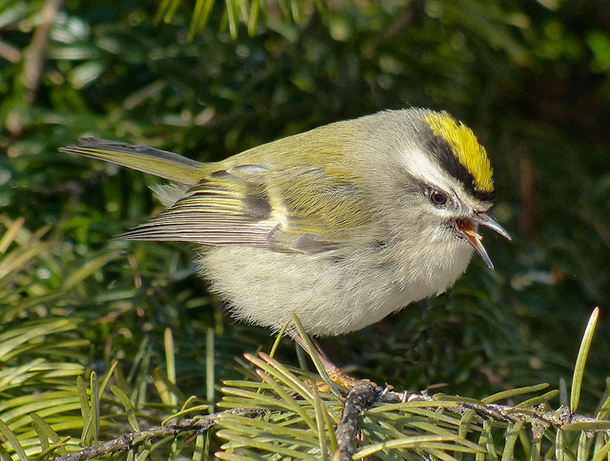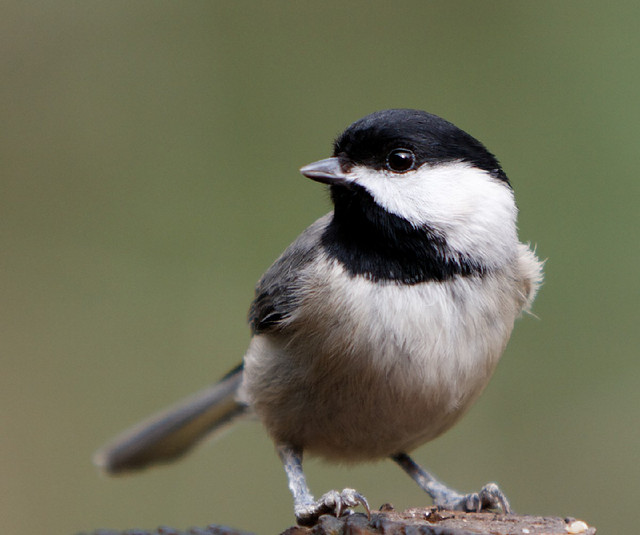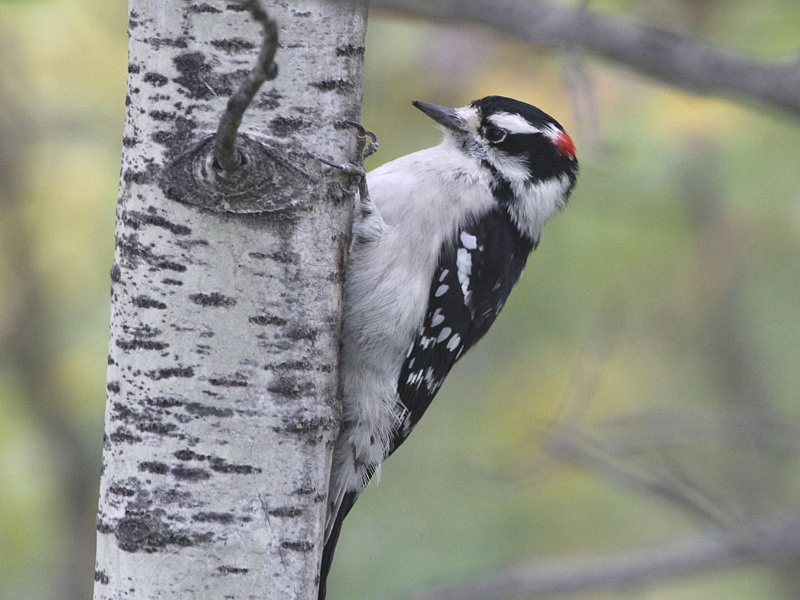BirdNote: Eating Well Together
Air Date: Week of March 6, 2015

Golden-crowned Kinglet (Photo: Eugene Beckes)
Many species of birds dine alone, avoiding competition for food, but the temperate woodlands’ chickadees, kinglets and downy woodpeckers forage and feast better together—rustling up more food than they would alone while keeping a watch for predators.
Transcript
CURWOOD: It's Living on Earth, I'm Steve Curwood.
[MUX - BIRDNOTE® THEME]
CURWOOD: Even where winter still holds its grip – longer days and the first day of spring in less than two weeks promise that warmer days and the growing season will finally arrive. And then there’s the promise we can find in flocks of wild birds. Here’s Mary McCann with today’s Birdnote®.
BirdNote®
Flocking and Foraging
[Winter flock of chickadees and kinglets]
MCCANN: Take a walk in a temperate woodland this month, and you might hear this chorus.
[Winter flock of chickadees and kinglets and Downy Woodpecker]
A closer look and listen reveals that this foraging flock includes several species of birds: chickadees, kinglets, and even a Downy Woodpecker.
[Downy Woodpecker]
Many bird species eat alone, so you might wonder why these birds have chosen to dine together.
Different species flocking together to find food, called commensal feeding, mutually enhances success. One species assists the foraging of others.

Black-capped Chickadee (Photo: Les Howard)
For example, in chickadee and woodpecker flocks, the woodpecker pecks off bark and moss, exposing grubs for its own consumption. But the pecking also stirs up flying insects that the chickadees swoop in to snatch.
The relationship also helps the woodpecker, because the extra eyes of the chickadees are on the lookout for predators. The watchdog chickadees alert the close-focused woodpecker when there’s danger.
[Chickadee sounding the notes of danger]
Because these birds, foraging together, don’t seek the same foods, the result is cooperative—or commensal—rather than competitive feeding.
[More flock with Downy Woodpecker]
I’m Mary McCann

A male Downy Woodpecker (Photo: Vitalii Khustochka)
###
Written by Frances Wood
Birdcalls provided by The Macaulay Library of Natural Sounds at the Cornell Lab of Ornithology, Ithaca, New York. Black-capped chickadee recorded by R.S. Little; Golden-crowned Kinglets by G.A. Keller, Downy Woodpecker call, by W.W.H. Gunn; and mixed flock by J. Storm.
Black-capped Chickadee 5 “dee” call recorded by C. Templeton
Photos: Black-capped Chickadee - Les Howard flickr.com/photos/leshoward/; Downy Woodpecker - Vitalii Khustochka flickr.com/photos/phenolog/; Golden-crowned Kinglet - Eugene Beckes flickr.com/photos/61210501@N04
Producer: John Kessler
Executive Producer: Chris Peterson
© 2015 Tune In to Nature.org Feb. 2015 Narrator: Mary McCann
http://birdnote.org/show/flocking-and-foraging
CURWOOD: To find photos and more...flock on over to our website. It’s LOE.org.
Links
Living on Earth wants to hear from you!
Living on Earth
62 Calef Highway, Suite 212
Lee, NH 03861
Telephone: 617-287-4121
E-mail: comments@loe.org
Newsletter [Click here]
Donate to Living on Earth!
Living on Earth is an independent media program and relies entirely on contributions from listeners and institutions supporting public service. Please donate now to preserve an independent environmental voice.
NewsletterLiving on Earth offers a weekly delivery of the show's rundown to your mailbox. Sign up for our newsletter today!
 Sailors For The Sea: Be the change you want to sea.
Sailors For The Sea: Be the change you want to sea.
 The Grantham Foundation for the Protection of the Environment: Committed to protecting and improving the health of the global environment.
The Grantham Foundation for the Protection of the Environment: Committed to protecting and improving the health of the global environment.
 Contribute to Living on Earth and receive, as our gift to you, an archival print of one of Mark Seth Lender's extraordinary wildlife photographs. Follow the link to see Mark's current collection of photographs.
Contribute to Living on Earth and receive, as our gift to you, an archival print of one of Mark Seth Lender's extraordinary wildlife photographs. Follow the link to see Mark's current collection of photographs.
 Buy a signed copy of Mark Seth Lender's book Smeagull the Seagull & support Living on Earth
Buy a signed copy of Mark Seth Lender's book Smeagull the Seagull & support Living on Earth

